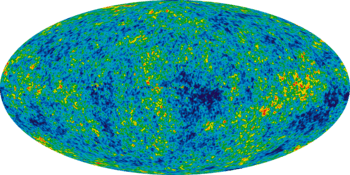Electroweak epoch
| Part of a series on | |||
| Physical cosmology | |||
|---|---|---|---|
 | |||
|
Early universe
|
|||
|
Components · Structure |
|||
| |||
In physical cosmology, the electroweak epoch was the period in the evolution of the early universe when the temperature of the universe was high enough to merge electromagnetism and the weak interaction into a single electroweak interaction (> 100 GeV). The electroweak epoch began when the strong force separated from the electroweak interaction. Some cosmologists place this event at the start of the inflationary epoch, approximately 10−36 seconds after the Big Bang.[1][2][3] Others place it at approximately 10−32 seconds after the Big Bang when the potential energy of the inflaton field that had driven the inflation of the universe during the inflationary epoch was released, filling the universe with a dense, hot quark–gluon plasma.[4] Particle interactions in this phase were energetic enough to create large numbers of exotic particles, including W and Z bosons and Higgs bosons. As the universe expanded and cooled, interactions became less energetic and when the universe was about 10−12 seconds old, W and Z bosons ceased to be created. The remaining W and Z bosons decayed quickly, and the weak interaction became a short-range force in the following quark epoch.
The physics of the electroweak epoch is less speculative and much better understood than the physics of previous periods of the early universe. The existence of W and Z bosons has been demonstrated, and other predictions of electroweak theory have been experimentally verified.
See also
References
- ↑ Ryden B: "Introduction to Cosmology", pg. 196 Addison-Wesley 2003
- ↑ Allday, Jonathan (2002). Quarks, Leptons and the Big Bang. Taylor & Francis. p. 334. ISBN 978-0-7503-0806-9.
- ↑ Our Universe Part 6: Electroweak Epoch, Scientific Explorer
- ↑ Lecture 13: History of the Very Early Universe, Dr. Balša Terzić, Northern Illinois Center for Accelerator and Detector Development
- Greene, Brian (2005). The Fabric of the Cosmos: Space, Time, and the Texture of Reality. Penguin Books Ltd. ISBN 978-0-14-101111-0.